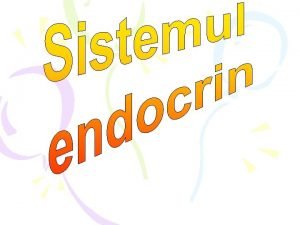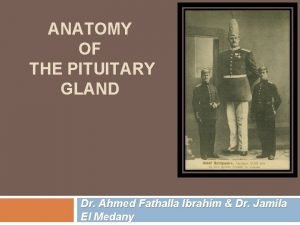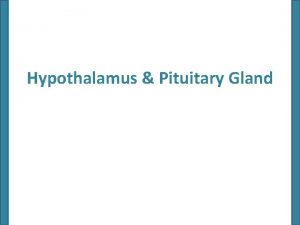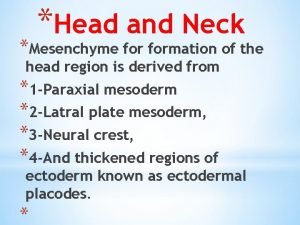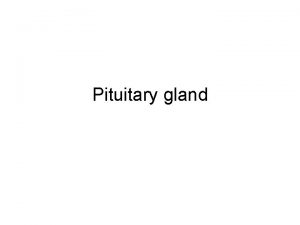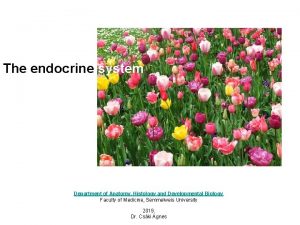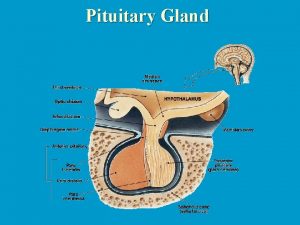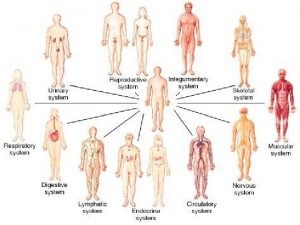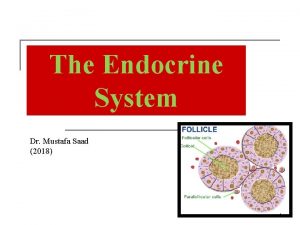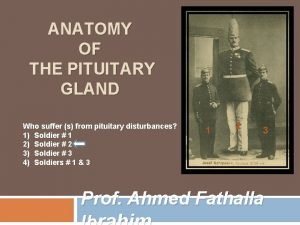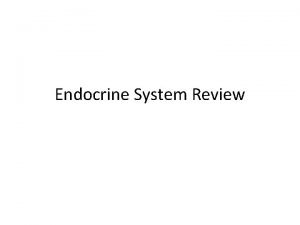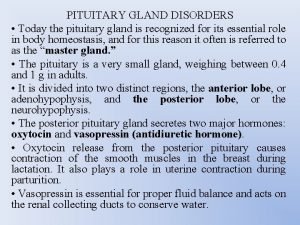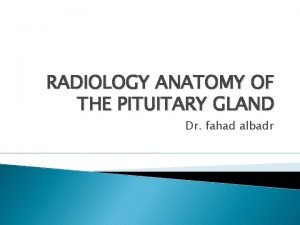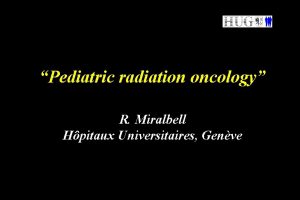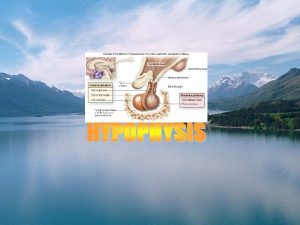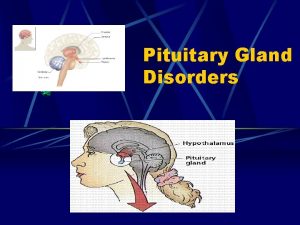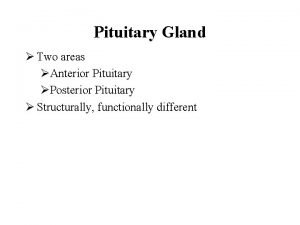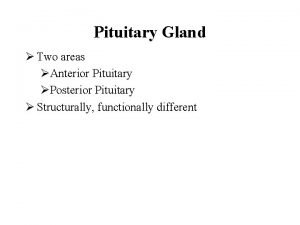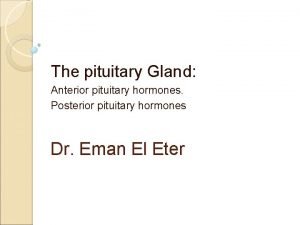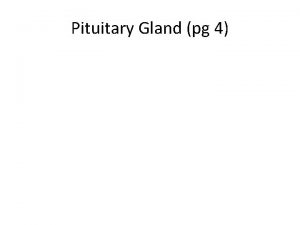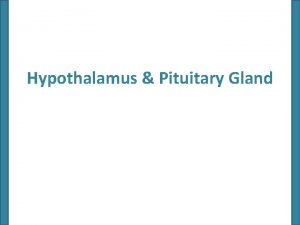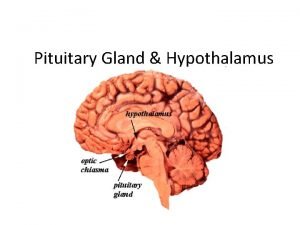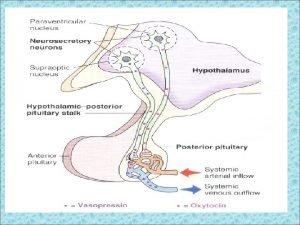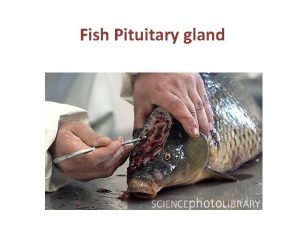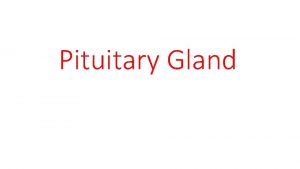THE PITUITARY GLAND Hypophysis Prof Dr Sherif Wagih


















- Slides: 18

THE PITUITARY GLAND (Hypophysis) Prof. Dr. / Sherif Wagih Mansour Prof. of Physiology dpt.

Hypophysis ØThe hypophysis: is a small gland , 1 cm in diameter, lies in the Sella Turcica at the base of the brain connected to the hypothalamus by the hypophyseal stalk. ØIt is a compound gland derived partly from a downgrowth of nervous tissue (posterior lobe) and partly from an upgrowth of the mouth (anterior lobe). ØThe arteries which supply the median eminence (lower most portion of the hypothalamus) are divided in its substance to form like primary capillary plexus and then coalescing to form the hypothalamic hypophyseal portal vessels which pass downward along the hypophyseal stalk to supply the anterior pituitary sinuses.

Secretion of Hypothalamic neurosecretory substances in the median Eminence : ØThe neurons originating in various parts of the hypo thalamus send fibers into the median eminence and tuber cinereum which secretes a small polypeptide hormones (hypothalamic hormones or neurosecretory substances) that are absorbed into the hypothalamic hypophyseal portal capillaries to be carried to the adenohypophysis. ØThey control the release of adeno hypophyseal hormones.

Secretion of Hypothalamic neurosecretory substances in the median Eminence : ØThey are called releasing or inhibitory factors according to their function : o Thyrotropin Releasing Factor (TRF) hormone inhibiting factor) o Gonadotropin Releasing Factor (GRF) o Corticotropin Releasing Factor (CRF) o Luteotropin (Prolactin) o Somatotropin Releasing Factor Inhibitory Factor (LIF) (SBF) o Melanostatin (Melanocyte Stimulating hormone release o Somatostatin (Growth Inhibitory Factor).

Somatostatin hormone ØIt is a Growth hormone release inhibiting factor. ØIt has been located in tissues other than the hypothalamus e. g. the pancreatic islets. ØWhen given parenterally it blocks the effect of TRH (thyrotropin releasing hormone) and suppresses the release of Growth hormone , prolactin , insulin and glucagon hormones. ØThe physiological role of this extraordinary substance is uncertain.

Adenohypophysis (Anterior pituitary ) It is composed of three types of cells : 1. Chromophobes: (50% of all cells) ØIt is the precursor cells of either alpha or beta cells. 2. Acidophils (alpha cells): (40% of all cells) ØIt produces: 1. Growth hormone. (GH) 2. Prolactin or Luteotropic hormone(LTH) 3. Basophils (Beta cells): (10% of all cells) ØIt produces: 1. Thyrotropin (TSH) 2. Corticotropin (ACTH) 3. Luteinizing H. (LH) 4. Follicle stim ulating H. (FSH)

1 -Thyroid stimulating hormone (TSH): Functions: 1. It stimulates the development of the thyroid structure and function. 2. It also stimulates the process of thyroxin formation (iodide trap, iodination of tyrosine, release of T 3, 4). Control: a. Negative Feedback Mechanism: between T 3 T 4 and TSH pituitary secretion and thyrotropin releasing factor from the hypothalamus. b. Thyrotropin releasing factor is stimulated mainly by neural reflexes.

2 -Adrenocorticotrophic hormone (ACTH) – Corticotropin: Functions: 1. It stimulates the development of the adrenal cortex structure and function except Zona glomerulosa. . 2. It stimulates the formation and secretion of all the adrenal cortex hormones except aldosterone hormone. 3. It has a fat mobilizing effect and a melanocyte stimulating effect. Control: a. Feedback mechanism : increase in adrenocortical hormones level in blood → inhibits ACTH secretion directly on the anterior pituitary and reflexly through inhibition of the hypothalamus. b. Neural Stresses : emotional excitement, pain and fear stimulate the hypothalamus to secrete corticotropin releasing factor to stimulate ACTH secretion. Circulatory stresses as hemorrhage and surgical trauma stimulate the anterior pituitary directly. c. ADH (vasopressin) stimulates corticotrophin release from the adenohypophysis , which it reaches via the hypothalamo hypophyseal portal system.

3. Gonadotrophins: Two hormones are secreted from the anterior pituitary to regulate the ovarian and testicular activity : a. Follicle stimulating hormone b. B Luteinizing hormone (LH) or interstitial cell stimulating hormone A- Follicle-stimulating hormone: Functions: In Females : It stimulates the growth and maturation of Graafian follicle and secretion of oestrogen from it. In Males : It stimulates spermatogenesis.

3. Gonadotrophins: B-Luteinizing hormone (LH) or interstitial cell stimulating hormone: In Female : It stimulates maturation and ovulation and formation of corpus luteum and secretion of progesterone. In Male : It stimulates the interstitial cells of Leydig and secretion of testosterone hormone. Control : a. Feedback mechanism : o Small and moderate doses of oestrogen stimulate FSH secretion while large dose of oestrogen inhibits FSH secretion. o Moderate dose of oestrogen stimulates LH secretion. o Increase in progesterone level in blood inhibits LH secretion and vice versa (as in normal ovulatory cycle). b. Hypothalamus : It secretes Gonadotropin releasing factor (LH-FSH-Releasing factor). Fear of pregnancy in girls and emotional upsets inhibit the releasing factors → inhibit FSH and LH secretion → stoppage of menstrual cycle.

4. Lipotrophin: ØIt is a large polypeptide in alpha and beta form released from the ACTH secreting cells of the anterior pituitary. ØThe Lipotrophin contains within it melanocyte stimulating hormone (MSH) and Endorphins. ØFunctions of Lipotrophin and the endorphins are unknown but endorphins are so called because of their endogenous morphine like action on the brain.

5. Growth hormone (GH) Somatotropin H. ØIt is a polypeptide hormone formed of 191 amino acids with a molecular weight of 22, 000. The growth hormone is metabolized rapidly in the liver which is responsible for its duration of action (20 minutes). ØFunctions: This hormone stimulates growth of all tissues of the body. It increases the size and number of the cells by : 1. 2. 3. 4. 5. Increase in the rate of protein synthesis Lipolytic and Ketogenic effect Decreases the utilization of carbohydrate for energy It increases calcium absorption from the G. I. T. It causes reabsorption of Na+ , K+, Ca++, P 04 , and C 1 from the kidney 6. Chondrogenesis and Bone Growth

5. Growth hormone (GH) Somatotropin H. 1. Increase in the rate of protein synthesis : o Adequate Insulin activity as well as adequate availability of carbohydrates necessary for growth hormone to be effective. • It enhance amino acids transport through the cell membrane. • It increases amino acids concentration for protein building and it decreases amino acid blood level. • It also causes enhancement of RNA translation to promote protein synthesis by the ribosomes. • it increases nuclear transcription DNA to form RNA This inturn promotes more protein synthesis.

5. Growth hormone (GH) Somatotropin H. 2. Lipolytic and Ketogenic effect : It increases mobilization of fatty acids and increases the use of fatty acids for supplying energy to the body. So, excess hormone → ketosis 3. Decreases the utilization of carbohydrate for energy : • It decreases the use of glucose for energy production as a result of increased utilization of fatty acids for energy. The fatty acids for a large quantities of acetyl Co. A that initiate ve feedback effects to block the breakdown of glucose. • It depresses the uptake of glucose by the cells , so it increases the blood glucose level up to 100% above normal (diabetogenic effect pituitary diabetes). • It increases insulin output (over stimulation) that causes burn out of the beta cells of the pancreas. • It increases hepatic glucose output. • It inhibits the hexokinase enzyme (effect opposite to insulin effect) and so, it inhibits glucose uptake by the muscles.

5. Growth hormone (GH) Somatotropin H. 4. It increases calcium absorption from the G. I. T. 5. It causes reabsorption of Na+ , K+, Ca++, P 04 --, and C 1 - from the kidney and so , helping bone matrix formation. 6. Chondrogenesis and Bone Growth : ØIn young subjects in which the epiphysis have not yet fused to the long bones , growth hormone stimulates chondrogenesis (proliferation of epiphyseal cartilage), and as the cartilaginous epiphyseal plates widen, they lay down more matrix at the end of long bones with stimulation of osteoblastic activity (bone forming cells) → increased length of long bones. ØIn adult subjects in which the epiphysis are closed the linear growth is impossible.

5. Growth hormone (GH) Somatotropin H. Control: 1. Feedback Mechanism: Hypoglycaemia and increased amino acid concentration in blood, especially Arginine , stimulate the release of G. H. . It is also released by muscular exercise, stress stimuli and glucagon hormone. Growth hormone feeds back to inhibit its own secretion and it is also inhibited by cortisol , free fatty acids and medroxy progesterone. 2. Hypothalamus: It secretes a Somatotropin releasing factor which stimulates the release of G. H. . Cellular depletion of proteins is the major factor that enhances SRF secretion (to correct the protein deficiency) beside stressful stimuli. The hypothalamus also release an inhibitory factor.

5. Growth hormone (GH) Somatotropin H. Mode of Action of Growth Hormone : The mode of action of G. H. is by acting on the liver to produce Somatomedins (or sulfation factor, as it stimulates the incorporation of sulfate into the cartilage), These are relatively simple peptides (Growth H. is a 191 amino acid polypeptlde) which induce growth promoting activities in many tissues and cartilage with a prolonged duration of action (20 hours).

 Pituitary gland and pineal gland spiritual
Pituitary gland and pineal gland spiritual Thyoid gland
Thyoid gland Blood supply of pituitary gland
Blood supply of pituitary gland Nerve supply to pituitary gland
Nerve supply to pituitary gland Hypothalamus hormones
Hypothalamus hormones Pituitary gland
Pituitary gland Colloid anatomy
Colloid anatomy Hypophyseal fossa and pituitary gland
Hypophyseal fossa and pituitary gland Embryonic origin of pituitary gland
Embryonic origin of pituitary gland Pituitary gland inferior view
Pituitary gland inferior view Prolactin hormones
Prolactin hormones Human body systems images
Human body systems images Hypophyseal fossa and pituitary gland
Hypophyseal fossa and pituitary gland Putery gland
Putery gland What is the name
What is the name Morphology of pituitary gland
Morphology of pituitary gland Pituitary gland disorders
Pituitary gland disorders Pituitary gland tumor mri images
Pituitary gland tumor mri images Brainstem glioma
Brainstem glioma


